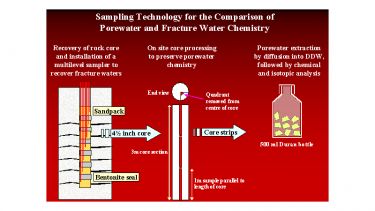Processes controlling the natural attenuation of fuel hydrocarbons and MTBE in the chalk aquifer
This study provides an integrated laboratory, field and modelling analysis of natural attenuation processes controlling the fate and transport of petroleum hydrocarbons (eg BTEX) and ether oxygenates (eg MTBE, TAME, TBA) in the UK Upper Chalk aquifer.

Summary
This ongoing research project has, over a four-year period, amassed an unparalleled dataset concerning contaminant fate and transport in the Chalk aquifer of SE England, the UK´s most important source of potable groundwater.
Regular monitoring of over 60 monitored intervals at the site of a recent fuel spill, together with chemical and geophysical analysis of in-situ chalk strata and chalk cores, has provided detailed insights into the impact of pollutants on aquifer chemistry and microbiology.
Of particular concern are the fuel oxygenates MTBE (methyl tert-butyl ether) and TAME (tertiary amyl-methyl ether), which are highly mobile and have uncertain biodegradation potential in groundwater.
Natural processes acting to reduce contaminant concentrations are being evaluated to determine whether an enhanced bioremediation strategy may be appropriate. Results from the study will be used to generate an improved methodology for the investigation of other, similar, sites.
Project aims
- To understand how dual porosity transport affects contaminant fate within the chalk aquifer.
- To determine key factors controlling rates of fuel oxygenate (MTBE and TAME) and BTEX biodegradation.
- The development of a predictive model for the behaviour of BTEX/ oxygenates in this aquifer setting.
- To investigate the options for enhanced bioremediation.
Scientific approach
Natural processes controlling the distribution of gasoline residues have been characterised using geophysical, chemical, microbiological and isotopic data.
Distinct zones of biodegradation have been identified and samples taken for microcosm studies of contaminant degradation rates under controlled laboratory conditions.
Experiments are also underway to determine effective diffusion coefficients through the chalk rock and the role of solute exchange between fractures and the chalk matrix.
Time series data from the field and laboratory is being used to calibrate numerical models of groundwater flow and contaminant transport.
Project partners
- School of Earth Sciences, University of Leeds
- CEH
- Lancaster Environment Centre
- UFZ Centre for Environmental Research, Leipzig, Germany
- Total UK
- CL:AIRE
- Environment Agency
